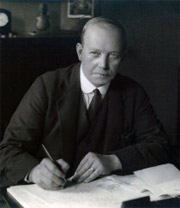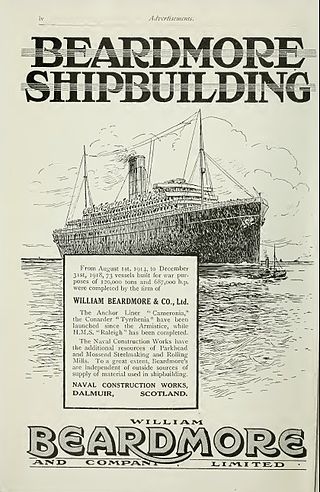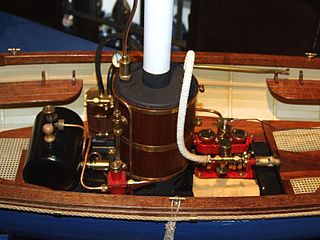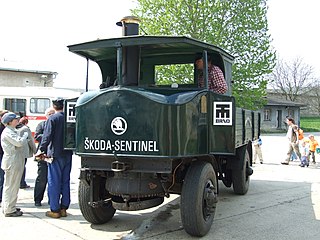
The Fairfield Shipbuilding and Engineering Company, Limited was a Scottish shipbuilding company in the Govan area on the Clyde in Glasgow. Fairfields, as it is often known, was a major warship builder, turning out many vessels for the Royal Navy and other navies through the First World War and the Second World War. It also built many transatlantic liners, including record-breaking ships for the Cunard Line and Canadian Pacific, such as the Blue Riband-winning sisters RMS Campania and RMS Lucania. At the other end of the scale, Fairfields built fast cross-channel mail steamers and ferries for locations around the world. These included ships for the Bosporus crossing in Istanbul and some of the early ships used by Thomas Cook for developing tourism on the River Nile.

Babcock & Wilcox is an American energy technology and service provider that is active and has operations in many international markets across the globe with its headquarters in Akron, Ohio, USA. Historically, the company is best known for their steam boilers.

Sentinel Waggon Works Ltd was a British company based in Shrewsbury, Shropshire that made steam-powered lorries, railway locomotives, and later, diesel engined lorries, buses and locomotives.

Archibald Keir Leitch was a Scottish architect, most famous for his work designing football stadiums throughout Great Britain and Ireland.

William Beardmore and Company was a British engineering and shipbuilding conglomerate based in Glasgow and the surrounding Clydeside area. It was active from 1886 to the mid-1930s and at its peak employed about 40,000 people. It was founded and owned by William Beardmore, later Lord Invernairn, after whom the Beardmore Glacier was named.

Oatlands is an area in the city of Glasgow, Scotland. It is situated south of the River Clyde, falls within the Southside Central ward under Glasgow City Council, and is part of the Gorbals historic area. Its boundaries are Hutchesontown and the Southern Necropolis cemetery to the west, Polmadie to the south, Shawfield to the east, and Glasgow Green public park to the north.

Polmadie is a primarily industrial area of Glasgow in Scotland. Situated south of the River Clyde, Polmadie is close to residential neighbourhoods including Govanhill and Toryglen (south-east), with Oatlands and another large industrial zone at Shawfield to the north on the opposite side of major railway lines and the M74 motorway, Junction 1A of which serves the area.

Kinning Park is a southern suburb of Glasgow, Scotland. It was formerly a separate police burgh between 1871 and 1905 before being absorbed by the city. In 1897, it had a population of 14,326.

A & J Inglis, Ltd, was a shipbuilding firm founded by Anthony Inglis and his brother John, engineers and shipbuilders in Glasgow, Scotland in 1862. The firm built over 500 ships in a period of just over 100 years. Their Pointhouse Shipyard was at the confluence of the rivers Clyde and Kelvin. They constructed a wide range of ships, including Clyde steamers, paddle steamers and small ocean liners. In wartime, they built small warships, and in the period after World War II, they built a number of whalers.
George Forrester and Company was a British marine engine and locomotive manufacturer at Vauxhall Foundry in Liverpool, established by Scottish engineer George Forrester. The company opened in 1827 as iron founders and commenced building steam locomotives in 1834.

A steam wagon is a steam-powered truck for carrying freight. It was the earliest form of lorry (truck) and came in two basic forms: overtype and undertype, the distinction being the position of the engine relative to the boiler. Manufacturers tended to concentrate on one form or the other.

The Riverside Museum is a museum in Glasgow, designed by Zaha Hadid Architects, housed in a building at Pointhouse Quay in the Glasgow Harbour regeneration district of Glasgow, Scotland. The building opened in June 2011, winning the 2013 European Museum of the Year Award. It houses many exhibits of national and international importance. The Govan-Partick Bridge will provide a pedestrian link from the museum across the Clyde to Govan. It is set to be completed in 2023.

A vertical boiler is a type of fire-tube or water-tube boiler where the boiler barrel is oriented vertically instead of the more common horizontal orientation. Vertical boilers were used for a variety of steam-powered vehicles and other mobile machines, including early steam locomotives.

The Sentinel boiler was a design of vertical boiler, fitted to the numerous steam wagons built by the Sentinel Waggon Works.

A steam motor is a form of steam engine used for light locomotives and light self-propelled motor cars used on railways. The origins of steam motor cars for railways go back to at least the 1850s, if not earlier, as experimental economizations for railways or railroads with marginal budgets. These first examples, at least in North America, appear to have been fitted with light reciprocating engines, and either direct or geared drives, or geared-endless chain drives. Most incorporated a passenger carrying coach attached to the engine and its boiler. Boiler types varied in these earlier examples, with vertical boilers dominant in the first decade and then with very small diameter horizontal boilers. Other examples of steam motor cars incorporated an express-baggage or luggage type car body, with coupling apparatus provided to allow the steam motor car to draw a light passenger coach.
The London, Midland and Scottish Railway (LMS) Sentinel No. 7164, was a small shunting locomotive. Its design was that of the single-speed Sentinel, a vertical-boilered geared locomotive, using Sentinel's standard vertical boiler and steam motor design. This was the smallest of the four Sentinel classes used by the LMS.
Metal Industries, Limited was a conglomerate of mostly British engineering companies. It was founded in Glasgow in 1922 by Robert Watson McCrone. In 1953 its activities were described as "electrical and mechanical engineering manufacture and metal trading" In 1967, Aberdare Holdings of South Wales acquired a controlling interest in the group, but was quickly thwarted when M.I. created a large tranche of new shares which it sold to Thorn Electrical Industries, giving Thorn overall control of the company. The City Panel on Takeovers and Mergers referred to "abuses and inequities" that occurred during this chaotic takeover, among others at the time, but declined to recommend tougher regulations. A good history of the company's shipbreaking activities was published by the World Ship Society in 1992 in Ian Buxton's "Metal Industries: Shipbreaking at Rosyth and Charlestown".
Glenfield is a large industrial manufacturing company based in Kilmarnock, Ayrshire, Scotland. At its height it was reckoned to be the largest company of its type in the Commonwealth.
The Sentinel Valve Works Ltd was a British company based in Worcester, England, that made medium, large and enormous valves initially for civic clean water distribution and sewage treatment, and later the production of valves for steam heating and electrical generation, and the chemical and petroleum industries. The company traded under the brand name Sentinel Valves.
Thermotank was a Scottish engineering company specialising in heating, ventilation and air conditioning, founded in Glasgow in 1900 by Alexander William Stewart and his two brothers William and Frederick. The business was based on Alexander’s invention, the Thermotank, a system designed for maritime use which could maintain a constant temperature coupled to a change of air on board ships.














